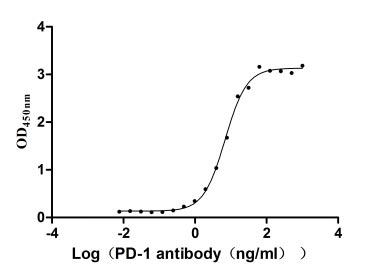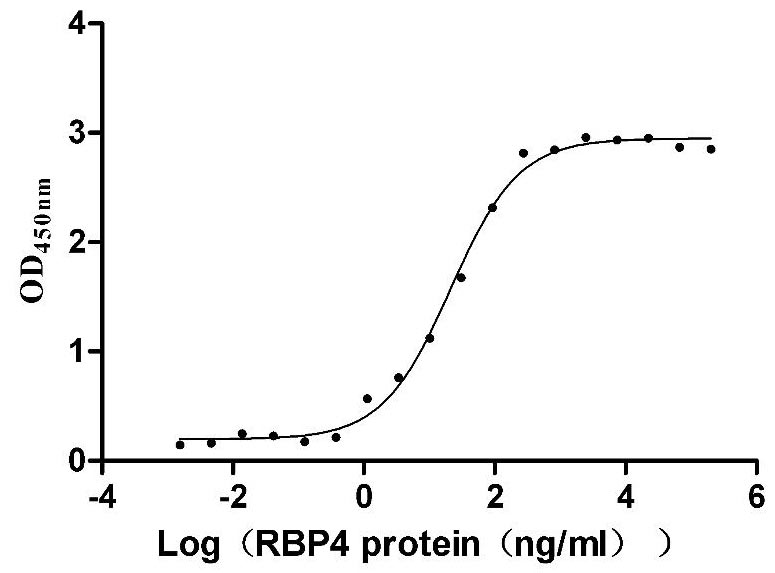Recombinant Mouse Polyadenylate-binding protein 1 (Pabpc1)
-
中文名称:小鼠Pabpc1重组蛋白
-
货号:CSB-YP017352MO
-
规格:
-
来源:Yeast
-
其他:
-
中文名称:小鼠Pabpc1重组蛋白
-
货号:CSB-EP017352MO
-
规格:
-
来源:E.coli
-
其他:
-
中文名称:小鼠Pabpc1重组蛋白
-
货号:CSB-EP017352MO-B
-
规格:
-
来源:E.coli
-
共轭:Avi-tag Biotinylated
E. coli biotin ligase (BirA) is highly specific in covalently attaching biotin to the 15 amino acid AviTag peptide. This recombinant protein was biotinylated in vivo by AviTag-BirA technology, which method is BriA catalyzes amide linkage between the biotin and the specific lysine of the AviTag.
-
其他:
-
中文名称:小鼠Pabpc1重组蛋白
-
货号:CSB-BP017352MO
-
规格:
-
来源:Baculovirus
-
其他:
-
中文名称:小鼠Pabpc1重组蛋白
-
货号:CSB-MP017352MO
-
规格:
-
来源:Mammalian cell
-
其他:
产品详情
-
纯度:>85% (SDS-PAGE)
-
基因名:
-
Uniprot No.:
-
别名:Pabpc1; Pabp1; Polyadenylate-binding protein 1; PABP-1; Poly(A)-binding protein 1
-
种属:Mus musculus (Mouse)
-
蛋白长度:Full length protein
-
表达区域:1-636
-
氨基酸序列MNPSAPSYPM ASLYVGDLHP DVTEAMLYEK FSPAGPILSI RVCRDMITRR SLGYAYVNFQ QPADAERALD TMNFDVIKGK PVRIMWSQRD PSLRKSGVGN IFIKNLDKSI DNKALYDTFS AFGNILSCKV VCDENGSKGY GFVHFETQEA AERAIEKMNG MLLNDRKVFV GRFKSRKERE AELGARAKEF TNVYIKNFGE DMDDERLKEL FGKFGPALSV KVMTDESGKS KGFGFVSFER HEDAQKAVDE MNGKELNGKQ IYVGRAQKKV ERQTELKRKF EQMKQDRITR YQGVNLYVKN LDDGIDDERL RKEFSPFGTI TSAKVMMEGG RSKGFGFVCF SSPEEATKAV TEMNGRIVAT KPLYVALAQR KEERQAHLTN QYMQRMASVR AVPNPVINPY QPAPPSGYFM AAIPQTQNRA AYYPPSQIAQ LRPSPRWTAQ GARPHPFQNM PGAIRPAAPR PPFSTMRPAS SQVPRVMSTQ RVANTSTQTM GPRPAAAAAA ATPAVRTVPQ YKYAAGVRNP QQHLNAQPQV TMQQPAVHVQ GQEPLTASML ASAPPQEQKQ MLGERLFPLI QAMHPSLAGK ITGMLLEIDN SELLHMLESP ESLRSKVDEA VAVLQAHQAK EAAQKAVNSA TGVPTV
-
蛋白标签:Tag type will be determined during the manufacturing process.
The tag type will be determined during production process. If you have specified tag type, please tell us and we will develop the specified tag preferentially. -
产品提供形式:Lyophilized powder
Note: We will preferentially ship the format that we have in stock, however, if you have any special requirement for the format, please remark your requirement when placing the order, we will prepare according to your demand. -
复溶:We recommend that this vial be briefly centrifuged prior to opening to bring the contents to the bottom. Please reconstitute protein in deionized sterile water to a concentration of 0.1-1.0 mg/mL.We recommend to add 5-50% of glycerol (final concentration) and aliquot for long-term storage at -20℃/-80℃. Our default final concentration of glycerol is 50%. Customers could use it as reference.
-
储存条件:Store at -20°C/-80°C upon receipt, aliquoting is necessary for mutiple use. Avoid repeated freeze-thaw cycles.
-
保质期:The shelf life is related to many factors, storage state, buffer ingredients, storage temperature and the stability of the protein itself.
Generally, the shelf life of liquid form is 6 months at -20°C/-80°C. The shelf life of lyophilized form is 12 months at -20°C/-80°C. -
货期:Delivery time may differ from different purchasing way or location, please kindly consult your local distributors for specific delivery time.Note: All of our proteins are default shipped with normal blue ice packs, if you request to ship with dry ice, please communicate with us in advance and extra fees will be charged.
-
注意事项:Repeated freezing and thawing is not recommended. Store working aliquots at 4°C for up to one week.
-
Datasheet :Please contact us to get it.
靶点详情
-
功能:Binds the poly(A) tail of mRNA, including that of its own transcript, and regulates processes of mRNA metabolism such as pre-mRNA splicing and mRNA stability. Its function in translational initiation regulation can either be enhanced by PAIP1 or repressed by PAIP2. Can probably bind to cytoplasmic RNA sequences other than poly(A) in vivo. Involved in translationally coupled mRNA turnover. Implicated with other RNA-binding proteins in the cytoplasmic deadenylation/translational and decay interplay of the FOS mRNA mediated by the major coding-region determinant of instability (mCRD) domain. Involved in regulation of nonsense-mediated decay (NMD) of mRNAs containing premature stop codons; for the recognition of premature termination codons (PTC) and initiation of NMD a competitive interaction between UPF1 and PABPC1 with the ribosome-bound release factors is proposed. By binding to long poly(A) tails, may protect them from uridylation by ZCCHC6/ZCCHC11 and hence contribute to mRNA stability.
-
基因功能参考文献:
- The nicotinamide adenine dinucleotide (NAD)-dependent deacetylase SIRT1 acts as an energy sensor and negatively regulates poly(A)RNA transport via deacetylating a poly(A)-binding protein, PABP1. PMID: 28756945
- These results demonstrate that EPAB is important for oocyte-somatic communication by maintaining transzonal processes and gap junctions at the preantral stage of folliculogenesis. PMID: 28203794
- The s found that the endogenous Zfp36 directly interacts with the cytoplasmic poly(A)-binding protein. Importantly, this interaction is required for the translational repression of Zfp36's target mRNAs in resolving inflammation. PMID: 28635594
- Data suggest that hnRNPLL specifically associates with cytoplasmic PABPC1 in both T-lymphocytes and plasma cells; PABPC1 promotes binding of hnRNPLL to immunoglobulin H (IgH, heavy chain) mRNA and regulates switching from mIgH (membrane isoform) to sIgH (secreted isoform) in plasma cells. (hnRNPLL = heterogeneous nuclear ribonucleoprotein L-like protein; PABPC1 = cytoplasmic poly[A]-binding protein 1) PMID: 28611064
- Superovulation with low or high doses of gonadotropins significantly altered Epab and Pabpc1 mRNA levels in GV oocytes, MII oocytes and 1- and 2-cell embryos compared with their respective controls. These changes most likely lead to variations in expression of EPAB- and PABPC1-regulated genes, which may adversely influence the quality of oocytes and early embryos retrieved using superovulation. PMID: 25034140
- Data (including data from studies in knockout mice) suggest that Epab (embryonic poly(A)-binding protein), which is oocyte specific, is required for ability of cumulus cells and granulosa cells to exhibit responsiveness to Egf/Egfr signaling. PMID: 26492470
- Epab(-/-) oocytes are smaller in size, contain peripheral germinal vesicles, and are loosely associated with cumulus cells PMID: 26134869
- These findings suggest that EPAB may predominantly play roles in translational regulation of the mRNAs during early oogenesis and folliculogenesis, but PABPC1 most likely perform these roles in the later terms of ovarian development along with EPAB PMID: 25370180
- Epab is dispensable for mouse spermatogenesis and male fertility. PMID: 24599567
- We analyzed the expression of sperm-specific Akap3 and the potential regulatory factors of its protein synthesis during mouse spermiogenesis. PMID: 24648398
- Both Epab and Pabpc1 expression increase during early postnatal life and reach their peak at D32 testis. PMID: 22814100
- our data support the concept that expanded ATXN2 undergoes progressive insolubility and affects PABPC1 by a toxic gain-of-function mechanism with tissue-specific effects, which may be partially alleviated by the induction of FBXW8. PMID: 22956915
- EPAB is necessary for oogenesis, folliculogenesis and female fertility in mice. PMID: 22621333
- PABPC2 was present in pachytene spermatocytes and round spermatids, whereas elongating spermatids still included PABPC1. PMID: 19020299
显示更多
收起更多
-
亚细胞定位:Cytoplasm. Cytoplasm, Stress granule. Nucleus. Cell projection, lamellipodium.
-
蛋白家族:Polyadenylate-binding protein type-1 family
-
数据库链接:
KEGG: mmu:18458
STRING: 10090.ENSMUSP00000001809
UniGene: Mm.371570
Most popular with customers
-
Recombinant Human Programmed cell death protein 1 (PDCD1), partial (Active)
Express system: Mammalian cell
Species: Homo sapiens (Human)
-
Recombinant Mouse Transthyretin (Ttr) (Active)
Express system: Mammalian cell
Species: Mus musculus (Mouse)
-
Recombinant Mouse Claudin-18 (Cldn18)-VLPs (Active)
Express system: Mammalian cell
Species: Mus musculus (Mouse)
-
Recombinant Human Claudin-4 (CLDN4)-VLPs (Active)
Express system: Mammalian cell
Species: Homo sapiens (Human)
-
Express system: Mammalian cell
Species: Homo sapiens (Human)
-
Recombinant Human Dickkopf-related protein 1 (DKK1) (Active)
Express system: Mammalian cell
Species: Homo sapiens (Human)
-
Recombinant Human Desmoglein-2 (DSG2), partial (Active)
Express system: Mammalian cell
Species: Homo sapiens (Human)
-
Recombinant Human Cell adhesion molecule 1 (CADM1), partial (Active)
Express system: Mammalian cell
Species: Homo sapiens (Human)




-AC1.jpg)


-AC1.jpg)












